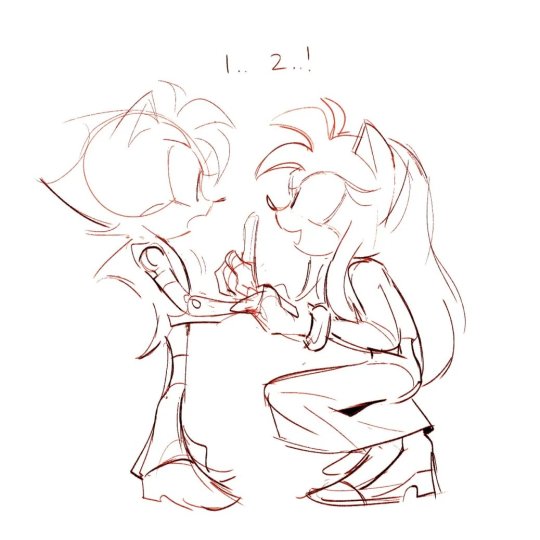#biosignatures
Explore tagged Tumblr posts
Text
Today in Strangeness:
On the night of February 24, 1942, the 'Battle of Los Angeles' took place. Eyewitness reports of an unknown object or objects over Los Angeles, California, triggered a massive anti-aircraft artillery barrage. A photo posted in the LA Times showed nine beams of light converging on an aerial object.
#coast to coast am#George Noory#Art Bell#Aliens#UAPRO#UFOs#UAVs#Paranormal#Supernatural#biosignatures
16 notes
·
View notes
Text
Bio Signatures discovered on planet 124 light years away
The planet is K2-18b.
"Bio Signatures" are compounds in the atmosphere which we would expect life to produce. Pretty much all of them have natural sources, but it's also extremely unlikely that life would not produce any of them.
Things like oxygen and methane like to react, leave the atmosphere, so they need replenishing. They are far from the only Bio Signatures but they do a fine job of illustrating the point...
There's also such a thing as "Techno Signatures," which would be things we would expect an industrial society to put into the atmosphere... pollution.
10 notes
·
View notes
Video
youtube
Beware of Biosignatures - Sixty Symbols
#youtube#interesting video#pairs nicely with the one with the lady from SETI#biosignatures#astronomy
2 notes
·
View notes
Text
New Study Debunks Earlier Hints of Alien Life on Exoplanet K2 18b, Reigniting Debate on Biosignatures
When scientists last year reported signs of dimethyl sulfide (DMS), a molecule on Earth mostly produced by marine life, on the exoplanet K2 18b, headlines erupted with excitement over the possibility of alien life. The planet, located 120 light years away in the habitable zone of a red dwarf star, suddenly became the most talked-about destination in our cosmic neighbourhood. However, fresh scrutiny from a new team of researchers has cast serious doubt over those claims, reminding the world just how complex and uncertain the search for extraterrestrial life remains.
#K2 18b#exoplanet life#alien life detection#dimethyl sulfide#biosignatures#James Webb Space Telescope#JWST#Nikku Madhusudhan#Julian Welbanks#astrobiology#extraterrestrial life#space research 2025
0 notes
Text
« Decades from now, we may look back at this point in time and recognise it was when the living universe came within reach. This could be the tipping point, where suddenly the fundamental question of whether we’re alone in the universe is one we’re capable of answering. »
0 notes
Text
Are there really traces of life on a planet 700 trillion miles away? Did the Easter Bunny really stuff aliens in our eggs this year? Some thoughts on the excitement quotient of alien marine goo vs knitted moon mice.

View On WordPress
0 notes
Text
SciTech Chronicles. . . . . . . . .April 18th, 2025
#DMS#three-sigma#K2-18b#biosignatures#Apennines#chlorine-36#paleoseismic#“slip rates”#ISRO#NASA#NISAR#“synthetic aperture radar”#“LMCN 1968-12a”#Hydrogen#“thermonuclear runaway”#silicon#Cross-shelf#eddies#“vertical water motions”#“mesoscale eddies”
1 note
·
View note
Text
Earth sciences isn’t just for Earth - Technology Org
New Post has been published on https://thedigitalinsider.com/earth-sciences-isnt-just-for-earth-technology-org/
Earth sciences isn’t just for Earth - Technology Org
W. Bruce Banerdt dreamed of becoming an astronaut. Space fascinated him as a young boy, and the thought of rockets and satellites surging through the universe sparked curiosity and excitement.
Saturn’s moon Titan could harbor life, and USC Dornsife’s Maya Yanez is helping NASA’s JPL look for it. Image credit: NASA
But Banerdt’s academic career pushed in other directions. He earned an undergraduate degree in physics in 1975 followed by a PhD in geological sciences in 1983, both from the USC Dornsife College of Letters, Arts and Sciences, and he seemed tethered to studying the history, nature, materials and processes of Earth, not outer space. That is until a graduate school colleague mentioned a summer internship studying the moon at NASA’s Jet Propulsion Laboratory (JPL) in Pasadena, California.
“To use the skills and knowledge I had acquired in physics and geology but in connection to space, well, it seemed too good to be true,” Banerdt says.
At JPL, Banerdt discovered Earth scientists played a significant role in understanding planets beyond our own, a mission Banerdt himself embraced with an inquisitive and enterprising spirit as an intern and, later, as a research scientist. Over a 45-year career at JPL, Banerdt worked extensively on projects investigating Mars while also contributing to efforts exploring Venus and Jupiter’s satellites.
As it turns out, space exploration isn’t merely the domain of pioneering astronauts like Neil Armstrong ’70 or James Lovell ’61, or the bailiwick of those at NASA or SpaceX. Banerdt, in fact, is among a number of USC Dornsife-connected Earth scientists — faculty, students and alumni among them — expanding human understanding of the solar system and laboring to unpack its many mysteries.
Trojans exploring the universe
Like Banerdt, Maya Yanez developed an early fascination with outer space. Holding an undergraduate degree in astronomy, the Los Angeles native is now a fifth-year PhD candidate in USC Dornsife’s Department of Earth Sciences and a former JPL intern.
Yanez’s doctoral studies focus on Titan, Saturn’s largest moon and, by some metrics at least, the solar system’s most Earth-like body. Titan is also one of only six places in the entire universe on which humans have landed a robot. In studying Titan’s current conditions, Yanez inspects similarities between where Titan is today and where the Earth might have been eons ago.
“We don’t know what we’re going to find, but everything — the data and the observations we make — informs our next steps, future projects, instrumentation and studies as well as the goals we’re setting for our next mission,” says Yanez, who works in the lab of Jan Amend, professor of Earth sciences and biological sciences.
The overarching goal, Yanez continues, is to better understand the habitability of Titan, the solar system’s only other world with stable liquids on its surface.
“In Earth, we have one example of life we have poked, prodded and studied, and we can use that to explore how life evolved elsewhere,” she says.
Many other USC-affiliated Earth scientists are similarly researching outer space.
Two USC Dornsife alumni, Laurie Barge ’09 and Scott Perl ’19, for instance, lead JPL’s Origins and Habitability Lab. Barge, Perl and their team of astrobiologists continue exploring the origin of life on Earth as well as if, and how, life could have started on other worlds. The lab also investigates how Earthly life persists amid extreme environments and the geochemical processes that make a planet habitable.
Professor of Earth Sciences Frank Corsetti, meanwhile, is a geologist who studies biosignatures, or signs of life. Corsetti’s research, heavily fueled by funding from NASA, aims to understand the evolution of life on Earth as well as the necessary parameters to create and sustain life. His work informs the search for clues and patterns of potential biosignatures on Mars.
And Banerdt capped his JPL career by directing the center’s Mars InSight Mission, which included designing, building and landing a seismometer on Mars. The instrument measured quakes and vibrations on Mars’s surface, offering rich insights into the basic building blocks of Earth’s closest planetary neighbor to help scientists develop theories and craft future experiments.
The Mars InSight lander explored the red planet, partially guided by USC Dornsife Earth sciences alum Bruce Banerdt. Image credit: NASA/JPL-Caltech
“It’s almost like doing an MRI of Mars,” says Banerdt, who likened InSight to scientists’ early 20th-century examinations of the Earth’s interior. “The composition and structure of a planet’s interior affects the surface environment of that planet, which is what makes life possible or impossible there.”
Earth scientists looking beyond the planet
While Earth scientists often focus on pressing global challenges like sustainability, water resources, climate change and natural resources, Corsetti and others say taking Earth sciences to outer space isn’t as wild or disconnected as it might initially seem. Studying the Earth — its origins, its environment and its materials — extends human knowledge of the solar system in powerful ways.
“When you step back 10 million miles, you realize Earth is just a planet, like many other planets, orbiting the sun,” says Banerdt, who retired from JPL last summer. “The same tools we use to study Earth can be used to study other planets and, similarly, we can use the study of other planets to inform our understanding of Earth.”
Such efforts position Earth’s inhabitants to address one of humanity’s most burning questions: Are we alone? Society can only begin to answer that question by first understanding how life evolved on Earth. Thereafter, Earth scientists can leverage their toolkits, like processes for chemical analysis, and instruments such as robotic rovers, particle detectors and spectrographs to develop greater clarity.
“Maybe we won’t find the evidence, but at least we can constrain what is possible, which is scientific progress,” Corsetti says.
It’s an undeniably energizing pursuit for Earth scientists like Yanez, who recalls looking up into the nighttime sky as a child and wondering about life beyond the planet.
“We have no idea what we don’t know,” she says. “To begin to use what we know to understand what we don’t know is super exciting to me, and I’m constantly being surprised because there are so many firsts left in space to discover.”
Source: USC
You can offer your link to a page which is relevant to the topic of this post.
#Analysis#Arts#astronauts#Astronomy#Astronomy news#biosignatures#Building#caltech#career#change#chemical#chemical analysis#climate#climate change#college#Composition#craft#curiosity#data#directing#earth#Environment#Evolution#Faculty#Funding#Future#Geology#Global#History#how
0 notes
Text
Quoting respected members of the scientific community that included UK astrophysicists Maggie Aderin-Pocock and Becky Smethurst, as well as astronaut Tim Peake, all of whom seemed to strongly allude to a discovery currently still on the path toward peer review
“I think we are going to get a paper that claims to have strong evidence for a biosignature in an exoplanet’s atmosphere very, very soon,” Smethurst was quoted saying. “Let’s just say it’s on my bingo card for 2024.”
Peake had been even less ambiguous while speaking during a CNBC interview in the first days of the new year, where he said the prospects that alien life might have been discovered were looking increasingly good.
“Potentially, the James Webb telescope may have already found [it],” though also emphasizing that nothing conclusive had been released yet since scientists involved in the prospective discovery “don’t want to release or confirm those results until they can be entirely sure,” though adding cryptically that “we found a planet that seems to be giving off strong signals of biological life.”
In other words, if these observations are what they appear to be, then it seems like there’s a good chance that we may already be on course for a tremendous discovery this year; one that could potentially offer the most convincing evidence to date that life may exist on worlds beyond our own.
0 notes
Text
"NASA has announced the first detection of possible biosignatures in a rock on the surface of Mars. The rock contains the first martian organic matter to be detected by the Perseverance rover, as well as curious discolored spots that could indicate the past activity of microorganisms."
"Since landing in Jezero crater a few years ago, Perseverance has traversed a series of rocks formed nearly four billion years before present. Mars back then was far more habitable than the cold, dry, toxic red planet of today.
There were thousands of rivers and lakes, a thick atmosphere, and comfortable temperatures and chemical conditions for life. Many of the rocks in Jezero are sedimentary: mud, silt and sand dumped by a river flowing into a lake.
The new discovery concerns one of these rocks. Informally named "Cheyava Falls" (a waterfall in Arizona), it is a small reddish block of what looks like a mudstone, enriched with organic molecules. The rock is also laced with parallel white veins. Between the veins are millimeter-scale whitish spots with dark rims. For an astrobiologist, all these features are intriguing."
continue reading
#mars#life on mars#mars biosignatures#mars atmosphere#ancient history#universe#cosmology#evolution#water on mars#nasa#perseverance rover#mars rover#organic matter#astrobiology#astrophysics#space#science
17 notes
·
View notes
Text
Idea Frontier #3: Biosignature Chemistry, Photonic Intelligence, Synthetic Scaling
Welcome to the third edition of Idea Frontier, where we explore paradigm-shifting ideas in STEM and business. In this issue, we examine three frontiers at the cutting edge of science and innovation: a breakthrough in detecting potential alien biochemistry, the rise of light-based AI computing, and the scaling of generative AI into biotechnology. Each topic illustrates a major shift – from theory…
#ai#AI Hardware#Astronomy#Biosignature Chemistry#Exoplanets#Photonic Intelligence#Photonics#Protein Folding#Synthetic Biology#Synthetic Scaling
0 notes
Text








my Metamy kid!! his name is Dusty Rose :D ft. single mom Amy Rose and Absentee baby daddy metal sonic LOL
his name's Dusty Rose after Dusty Miller, a plant that looks like metal/silver. Dusty Rose is also a pink color ! it also rhymes with Rusty Rose. im so smart (/j)
born from Metal Sonic's core and infused with Amy's biosignature, Amy and Metal Sonic had a very brief 'thing'... eventually Metal Sonic was soft rebooted and sent away yet again, but he left a piece of himself (part of his 'core'? infused with chaos energy..?) to Amy, which then became Dusty. leaving Dusty as the last true remaining testament of their love
(I just love the idea of Amy with a Waitress style character arc... finding love again in raising her child and not the way she used to think, being spent with another person)
Dusty would be very fixated on the idea of love, after all his mother raised him on the notion of that. Amy's standards for true love and fairytale romance have definitely changed being with Metal Sonic, but the root message being that love is all encompassing and transformative.
He was 'created' to look like Mobian, and Amy treats him no differently than any other Mobian/human. Still, he believes that he should hide all the parts that 'other' him from society, which means his robot parts. (legwarmers!)
He's got a bit of a bad boy edge to him LOLLL i kind of created him that he'd be an emo kid. (fall out boy.. my chemical romance.. a bit of IDKHow) really good at electric guitar and part of a band. eventually he finds his passion is in lyric-writing (all those love stories and inheriting his mother's gift for writing love letters)
he often wonders what a beating heart is like, as someone without one. he's interested in the heartbeats and the pulses of others, but he is a total sweetheart himself.. still, even to other mobians unaware that he is an android (a weapon at that), it's still a little off-putting..
more abt him belolow
Dusty's core is already made/designed after Amy's biosignature, and in meeting other people, he's able to read their biodata and stash it into an archive, but he doesn't reproduce it onto himself. (though unsure if he could? either his code has a blockade or he chooses not to)
Dusty, additional to his stash of weapons, has the ability to shift too like his papa... become something similar to Metal Overlord but not entirely... like a half robot dragon boy or smth.. IF he's under the right conditions to have it pulled out of him. or something
Dusty DOES "grow" up. basically, he's an inorganic being whose core is trying to emulate/copy the growth progression of other organic beings.
As it would grow in size (and Dusty's cognition "matures"), his mother and her friends would modify as needed to adjust his frame, etc, but rarely were things ever replaced. Like a mollusk, its shell growing in size- but one needing accommodations. A heart bigger than its own body that threatens to spill- a chick that has outgrown its shell, well before its expected date- needing modifications to keep it inside and protected
Metal Sonic and Amy would have something profound-- one of those tragic, star-crossed enemies-to-lovers dark fantasy romance stories Amy's always loved to read about- but then having it play in real time and having to come to terms with the real world implications of actually having one. It's just that- a fantasy. and metal sonic would grapple with the ideas of love, which i think would be inherently dark and a little possessive given his upbringing-- but what him and Amy have would be sweet at the very core of it. so him giving a piece of his core that reads and adapts to Amy's biosignature and oops... accidental baby....
Dusty finds himself drawn to music. his mom and dad couldn't quite communicate love language physically (with Metal Sonic's claws and his lack of mouth) so I hc that Amy taught Metal Sonic how to hum and sing and communicate their love through music and vocalizations (which carried onto Dusty)
4th pic is Dusty doing breathing exercises with his mama... Dusty gets embarrassed super easily so him and Amy would regularly do breathing exercises so he doesn't overheat like a PC
1K notes
·
View notes
Text
tag dump
#ic ; cowl on#promo ; batsignal#asks ; case files#starter call ; on the rooftops#plotting call ; mission brief#ooc ; cowl off#dash commentary ; the forums#memes ; utility belt#headcanons ; personnel files#art ; biosignatures#musings ; status report
1 note
·
View note
Text


Webb Detects Possible Biosignature Gases in Atmosphere of K2-18b
Astronomers using the NASA/ESA/CSA James Webb Space Telescope have detected the chemical fingerprints of dimethyl sulfide (DMS) and/or dimethyl disulfide (DMDS) in the atmosphere of the super-Earth exoplanet K2-18b. On Earth, DMS and DMDS are only produced by life, primarily microbial life such as marine phytoplankton. While an unknown chemical process may be the source of these molecules in K2-18b’s atmosphere, the results are the strongest evidence yet that life may exist on an extrasolar planet.
K2-18 is a red dwarf located approximately 111 light-years away in the constellation of Leo.
Also known as EPIC 201912552, the star hosts two massive exoplanets: K2-18b and K2-18c.
First discovered in 2015, K2-18b has a radius of 2.6 times that of Earth and is about 8.6 times as massive.
The planet orbits its star every 33 days at a distance of approximately 0.15 AU and has an Earth Similarity Index of 0.73.
It receives 1.28 times the light intensity of Earth, and its equilibrium temperature is minus 2 degrees Celsius (28 degrees Fahrenheit).
Earlier observations of K2-18b identified methane and carbon dioxide in its atmosphere. This was the first time that carbon-based molecules were discovered in the atmosphere of an exoplanet in the habitable zone.
Those results were consistent with predictions for a Hycean world: a habitable ocean-covered exoplanet underneath a hydrogen-rich atmosphere.
source
#exoplaneta#exoplanet#space#astronomia#astronomy#astrobiology#astrobiologia#jwst#jameswebb#life#extraterrestrial life
309 notes
·
View notes
Note
In this case it’s “if we assume this simplified model of the atmosphere of this exoplanet is accurate, there is a 2/3 chance we detected chemicals that can be produced by life (and are on Earth), but which are also known to be produced by abiotic processes elsewhere in the universe.” A lot hinges on the “if this simplified model is correct” part; there is a lot that is uncertain about K2-18 b, including whether it has any water at all.
Even if K2-18 b has water, it’s a mini-Neptune, and there’s good reason to think such planets might not be conducive to life even if they are in a star’s habitable zone. If K2-18 b has a global ocean, it’s hundreds of miles deep, with a thick layer of exotic high-pressure ice between the water and the rocky core of the planet. In such an environment, you wouldn’t get stuff dissolving into the ocean, or any kind of volcanic processes creating interesting chemical gradients like what likely drove the development of life on Earth.
have you spoken on the aliens yet. do u know that theres like 1/3rd chance we found aliens the other day
With all due respect whenever a scientific publication says weve definitely found aliens it turns out to be a "we definitely brought back dire wolves" type situation. I'll believe it when we have a sample of an actual extraterrestrial microbe.
#to be confident an exoplanet likely has life#I would like to see the detection of multiple kinds of biosignature#in the atmosphere of a rocky planet#but small rocky planets in the habitable zone are hard to observe
1K notes
·
View notes
Text
Two tropes I love are TimKon Clone Baby AUs and Tim being of Asian descent, so what if we combine them?
In his grief induced, sleep deprived spiral Tim manages to produce a viable embryo and conks out right after confirming that it has no detectable defects and will not terminate if he takes his eyes off it.
When he wakes up he realizes how fucked up this whole situation is but by then accelerated aging has already grown the child to be visible with the naked eye and Tim can't bring himself to abort it despite the moral concerns and ramifications of keeping it. It's not Kon, he knows that, but it's the closest he has to him so he decides to let incubation progress and deal with the consequences.
He stops the accelerated growing to give himself more time organising how he's going to mange this and so he can tell the relevant people beforehand instead of just turning up with a child. But then Bruce dies, or so everyone thinks, and Tim leaves to get him back himself when it becomes clear that he can't rely on anyone to help.
His search for Bruce works on a different time schedule driven by desparation and recklessness because he needs to get back to the child as fast as humanly possible. This causes him to take more risks and be less forgiving in his actions and he manages to gather enough evidence sooner. He sends the information to the JL and makes sure to prevent Ra's from continuing the fight in Gotham before getting the kid and dropping off the grid, letting everyone else make their own assumptions on what happened to him. Their actions when he confided in them about his theory had shown him that he can't trust them anymore, so he leaves.
He rushes to prepare his departure with the now born baby and leaves for his mother's childhood home in the Philippines. He'd visited it a few times with his mother and once with Kon but nobody else knows about it. (What Tim doesn't know is that in his haste to disappear he forgot to erase the simplest thing.)
Tim raises the child there, learning more about his own heritage and meeting estranged family members along the way.
He's using tech to disguise himself, appearance and biosignatures, from both the Justice League and the remains of Ra's empire, with Tam and Pru keeping him up to date on significant happenings respectively.
Meanwhile Dick has been worrying about Tim, which is only amplified when Bruce comes back and Tim doesn't, when Bruce asks about him and Dick doesn't have an answer, when Kon and Bart return with grandiose tales of the future to no best friend to tell them to.
Bruce starts searching for Tim during his recovery and Cassie catches Kon and Bart up to everything that happened between their deaths and Tim's disappearance.
They notice she's holding back on telling them something and she reluctantly shares how she caught him trying to clone Kon. Kon, overwhelmed and disturbed by the news, leaves them to process by himself. When he's calmed down and rationalised that he doesn't have the whole story, since Tim isn't here to tell it, he goes to the lab to look for... anything, really. A notebook, a diary, something that can tell him what Tim was thinking.
He finds the lab empty, all notes and cloning equipment destroyed. But on the computer he finds evidence that Tim was here after he disappeared, and that the cloning was successful.
So Kon is sure that Tim is out there, that he's with a child and that he went of his own accord. Where would Tim go, avoiding everyone that would search for him? That could be anywhere!
But does the child, his child, change his decision making? Kon can think of one place, far enough to not raise unwelcome memories of what he's leaving behind, sentimental enough to want to introduce his child to and secret enough that only one other living person knows about it. Or no other, considering that Tim was gone before he could find out that Kon's alive from anyone in the community and the news isn't public yet.
Kon flies to the home Tim had shown him once and finds it lived in. Toys and food and clothes and pictures all over the place. But no Tim and no baby. So Kon waits.
Tim comes back a few hours later, child in tow, from visiting his great aunt and uncle who he has started visiting regularly to learn about his family's history and share about his and his mother's lives in America. They're slowly starting to not need his cousins to translate anymore as Tim is learning enough Filipino to make up for their limited English.
The sight that greets Tim when he rounds corner is Kon tracing the pictures that Tim has taken and hung up since moving here.
Tim bursts into tears as he sees Kon, who himself startles, at Tim's entrance. They have a long, tearful reunion before Kon asks about the kid and Tim explains everything.
In the end Kon isn't happy about what happened but he sees the difference in how Clark and Luthor treat him to how Tim loves the child. He sees how Tim regrets hurting Kon with his actions and how what he did was not out of greed but out of grief.
Kon visits often after that, getting introduced to Tim's extended family and Tam and Pru. He eventually brings up letting other people know and Tim's apprehensive but lets Kon bring Bart the next time. Bart who is ecstatic at being an uncle and will definitely spoil the kid rotten. Together they manage to convince Tim to give telling other people a try, not necessarily about the kid or his location but at least that he's alive.
So Tim starts video calls with Bruce and Dick and Cassie, telling them that he's fine but that he won't come home, talking about what happened and how each of them hurt because of it. Eventually he'll let Kon take him for a visit in person. Eventually he'll tell them about his son, scared and hopeful, and they'll tell him that they'd love to meet him. Eventually he introduces them and watches everyone coo and baby talk to him.
Eventually Tim's anxiety about seeing them will turn into excitement and his son will grow up knowing his family in the Philippines and his family in America.
#tim drake#dcu#batfam#red robin#conner kent#kon el#timkon clone baby au#could be romantic or platonic#in my heart they're in love#bruce wayne#dick grayson#asian american tim drake#cloning#heritage#filipino tim drake#it would be really cool if somebody who knows about filipino culture wrote this and made the parts with Janet's side of the family authenti
276 notes
·
View notes